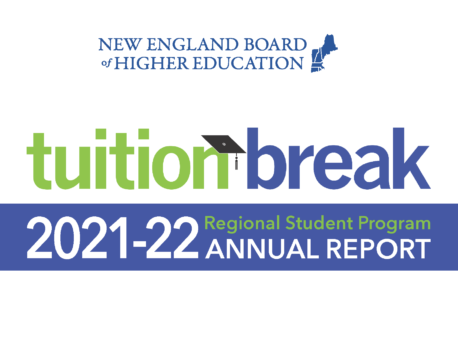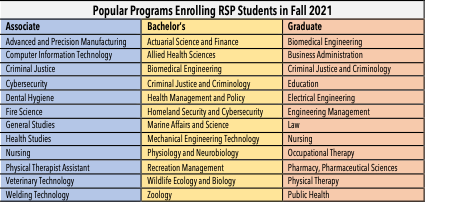
In its 64th year of enrollment, the New England Board of Higher Education’s Tuition Break, the Regional Student Program (RSP), continued to enhance access and affordability for residents of the six New England states while helping to support enrollment at the region’s public colleges and universities.
The 9,101 students enrolled in programs offered through the RSP in fall 2021 saved an estimated total of $64.8 million on their annual tuition bills. A full-time student saved an average of $8,600.
Since the first year of enrollment in 1957, the RSP has provided New England students and families savings on more than 342,000 annual tuition bills, with total savings in the billions of dollars.
The RSP benefits eligible students by providing significant savings on out-of-state tuition and access to hundreds of academic programs offered out-of-state, many in high-demand fields.
For the participating campuses, the RSP helps them attract and retain out-of-state New England students. The region’s public colleges and universities received an estimated $150 million in tuition and fee revenue from the RSP students enrolled at their campuses in 2021-22. The RSP also promotes resource sharing among the region’s public higher education systems, reducing the need to duplicate programs offered in nearby states.
RSP enrollment saw more positive trend than general enrollment; 50% of institutions saw RSP enrollment increases
Changes in RSP enrollment in fall 2021 compared favorably against changes in overall enrollment.
Nationally, total enrollment at public and independent higher education institutions (HEIs) declined by 2.7% in fall 2021, following a 2.5% decrease in fall 2020, according to the National Student Clearinghouse’s (NSC) January 2022 report, Current Term Enrollment Estimates, Fall 2021. Total RSP enrollment in fall 2021 decreased by only 0.4%, and RSP enrollment increased at half of the participating institutions.
RSP enrollment in fall 2021 at the public four-year campuses was level with the previous fall and decreased 1.7% at the two-year campuses. By contrast, public four-year enrollment nationally decreased by 3% and public two-year enrollment by 3.4%,
Specialized programs among popular programs
Popular programs where RSP-eligible students enrolled in fall 2021 included homeland security, engineering technologies and health sciences.
The participating colleges and universities allow eligibility for a wide array of degree programs in all areas of study, including specialized programs that are n ot offered by public HEIs in the students’ home-state.
ot offered by public HEIs in the students’ home-state.
Highlights of each state’s participation, including lists of popular programs where residents were enrolled are extracted here: Connecticut, Maine, Massachusetts, New Hampshire, Rhode Island and Vermont.
This year’s Tuition Break Annual Report is based on data gathered through NEBHE’s fall 2021 survey of New England public higher education institutions that participate in the RSP. The report provides data by state, institution and program.
NEBHE established the RSP in 1957-58 to fulfill the purposes of the congressionally authorized New England Higher Education Compact—expanding educational opportunities for New England residents and sharing higher education resources. The RSP has been increasingly branded as the Tuition Break.
Wendy A. Lindsay is senior director of NEBHE’s Tuition Break (Regional Student Program).
[ssba]
